Abydos
A police convoy again, with a new guide, Besam, who is a 26 year old bodybuilder-egyptologist. It’s almost three hours to Abydos, taken in a convoy. This led to some odd conversations and in a fit of TMI expose, Besam revealed that he is a virgin (because of the bodybuilding). Why he told us this, I have no idea!
Abydos King List
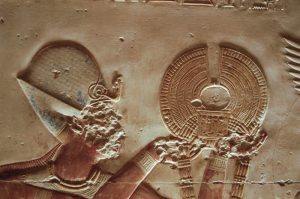
The Temple of Seti I in Abydos, (which involved not only the long drive but a truly scary bathroom) is interesting, if only for the reliefs of both Seti (bas relief) and incised carvings of Ramesses II. who “added on” when he took the throne. The bas-relief is very fine work on fine white limestone with amazing details. It reminded me very much of the Tombs of the Nobles on the west bank of Luxor – fine, almost delicate works of art, many of them still painted brilliant colors.
The temple reminds me of Hatshepsut’s temple, with a long ramp entering the terrace with the temple itself. This temple is strange, as well — having seven sanctuaries, for six of the major gods and Seti himself, as god-pharaoh. However, the temple is best known for the king list.
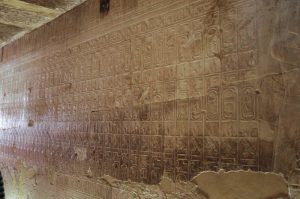
The Abydos king list, on a wall on the left hand side of a narrow hallway, is an enormous detailed series of cartouche after cartouche of all the kings from the first dynasty to Seti. This is one of the primary sources of info about the lineage of the pharaohs, although it should be taken with a grain of salt — like any king, Seti had political reasons for listing the kings and there are a few omissions from the list that are meaningful — Hatshepsut is completely missing, and the whole of the Amarna period is left out.
Osirieon
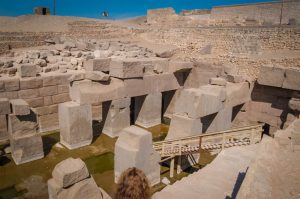
The cenotaph of Osiris (Osireon) is a very simple, squared structure, mostly under water now. Mark and Besam walked down the causeway to see if he could see the sanctuary, but no luck. I was watching them and then poof! Both he and Besam disappeared. I had visions of them sliding down into the guts of the lake, but they had only tried to sneak into the other end of the causeway. They said they could see the carvings and colors, but the ends were blocked off with locked gates. I only ventured down the rickety stairs to the bottom of the chapel to look around.
The bathroom at the temple was about 2″ deep with water..which of course I didn’t really notice until I’d dropped my khakis. At least they dried quickly. Yuck! At least this bathroom had a back wall — one of the “bathrooms” at the Valley of the Workers was a wooden trailer with a canvas skirt. Inside was a very nice, western-style toilet (with no seat).and absolutely no back wall at all. Just the rocky hill. I wasn’t entirely sure there was plumbing, but I didn’t actually look that closely. Sometimes you just have to ignore those things. And remember to bring your own toilet paper.
Dendara
Temple of Hathor
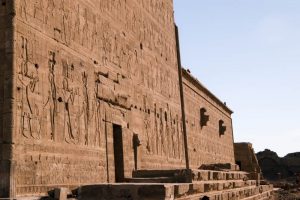
Back to Quena to see Dendara, which is Besam’s home town. This temple to Hathor is nearly complete — a feat in and of itself. The only other temple we’ve seen that has a roof and most of the interior rooms in place is Edfu, and this one is much larger and more complete. Like all other temples, this one would have been plastered white and brightly painted.
On the grounds (within the faint traces of the outer walls of mud brick) is a sacred pool and a number of other structures, including a mammisi (birth house) with Hathor-headed columns, and a greco-roman chapel. There were few tourists here, even in mid afternoon, and we had a chance to walk around and poke into all the corners.
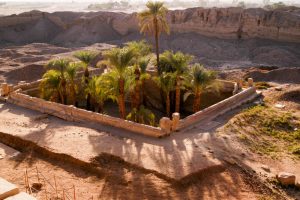
I’m always impressed that you can simply walk up and touch most of the monuments in Egypt. I would expect that the carvings and buildings would be cordoned off, or behind glass or something, so the thousands of moist, tourist hands couldn’t touch them. But, other than a few carefully restored tombs which are indeed behind glass, most of the carvings and paintings are out in the open. Not that you should touch them, of course, but for me — a dyed-in-the-wool-museum-toucher — it’s hard to resist the urge to run your fingers over the smoothly carved line of on of the bas-relief scenes, or poke them into the deeply carved recesses on the outside of the pylon. I spend a lot of time with my hands in my pockets.
 You can go up on the roof at Dendara (with a small tip to the guard). From the top of the pylon (with no railings, of course), Besam pointed out his family home. We could see fro miles from the roof. I felt a little uneasy walking on the stone slabs of the roof — i mean, what exactly what holding these things up anymore? (Answer — the columns in the hypostyle hall, but I couldn’t think of that). There are a few holes to watch our for: while some of them have grates, others would dump you thirty or forty feet down into the belly of the temple. I think Mark had to grab my arm a few times as I wandered around, utterly distracted.
You can go up on the roof at Dendara (with a small tip to the guard). From the top of the pylon (with no railings, of course), Besam pointed out his family home. We could see fro miles from the roof. I felt a little uneasy walking on the stone slabs of the roof — i mean, what exactly what holding these things up anymore? (Answer — the columns in the hypostyle hall, but I couldn’t think of that). There are a few holes to watch our for: while some of them have grates, others would dump you thirty or forty feet down into the belly of the temple. I think Mark had to grab my arm a few times as I wandered around, utterly distracted.
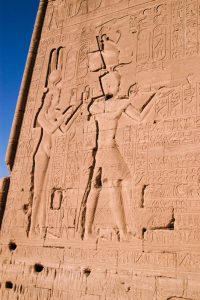
The carvings of Horus and Isis on the pylon, seen from the roof, are spectacular. I could have stayed up there for hours, just imagining what the temple would be like, bustling with hundreds of priests and acolytes and slaves.
Young children were selling yarn-and-popsicle-stick stars in the parking lot as we left — you know, those kindergarten projects with colored yarn wrapped around a cross of sticks. For a pound apiece, we bought a few, just because.
Quena
We abandoned the police escort on the way back to Luxor. Driving through Quena was odd — it looks like a clean, modern city….without a single person on the streets. Quena used to be suggested as a base for exploring this region of Egypt but most guidebooks now say to avoid it — or at least be very careful here, as it can be unfriendly to tourists.